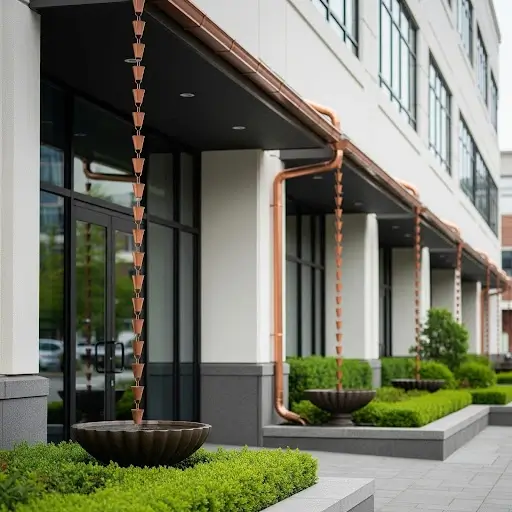Rain chains offer a unique alternative to traditional downspouts, guiding water from gutters to the ground with both functionality and visual appeal. While they are more commonly found on residential homes, rain chains are gaining attention for commercial buildings as well, providing a thoughtful blend of design and practical water management.
If you’re thinking about installing rain chains on a commercial property—or even on your home—it helps to understand when and where they work best. Getting the right fit can mean balancing aesthetics, water volume, safety, and maintenance to suit your specific needs.
What Are Rain Chains?
Rain chains are a series of linked cups or chains that hang from gutters, directing rain water visibly and gently to the ground. Instead of the enclosed flow of a standard downspout, water travels down the chain or cups, creating a calming sound and an attractive feature.
Materials vary and include copper, aluminum, steel, and other metals. Designs range from simple linked chains to artistic, decorative shapes. Their open design can reduce clogging issues compared to traditional downspouts.
Why Consider Rain Chains for Commercial Properties?
Enhanced Visual Appeal
For businesses where curb appeal matters—cafes, galleries, offices in vibrant neighborhoods—rain chains add an elegant, welcoming detail that blends architectural function with style.
Environmental Integration
Rain chains make rainwater management more visible and natural. When paired with rain gardens or decorative basins, they demonstrate a connection to sustainable water practices.
Calming Soundscape
The gentle trickle of water flowing down rain chains can enhance outdoor spaces such as patios or courtyards, creating a peaceful ambiance.
Maintenance Considerations
Compared to enclosed downspouts, rain chains are less prone to clogging by leaves or debris, which can mean less frequent cleaning in some situations.
When Do Rain Chains Work Well on Commercial Properties?
- Roof Size & Water Volume: Rain chains are best suited for moderate roof sections. Large commercial roofs with heavy rainfall require traditional downspouts to handle volume efficiently.
- Traffic & Location: Install rain chains in low-traffic areas where they won’t be damaged or interfere with pedestrian movement—think courtyards, garden zones, or outdoor seating areas.
- Local Building Codes: Always check local regulations to ensure rain chains comply with drainage and safety standards.
- Noise Sensitivity: While many enjoy the sound of flowing water, some commercial environments may find it distracting.
Where Are Rain Chains Most Suitable?
- Entrances & Patios: When space allows, rain chains can create charming focal points without obstructing walkways.
- Smaller Roof Sections or Awnings: Manageable water flow helps prevent overflow issues.
- Landscaped Zones or Rain Gardens: Direct water into natural or decorative drainage areas to protect foundations and reduce runoff damage.
- Architectural Highlights: Use rain chains to complement or accentuate building features.
Avoid placing rain chains where water runoff could cause slippery surfaces or damage foundations.
Key Installation Considerations
- Material Durability: Choose sturdy, weather-resistant metals like copper or stainless steel for longevity.
- Secure Attachment: Properly anchor rain chains to gutters to prevent swinging or damage.
- Effective Ground Drainage: Use splash blocks, gravel beds, or drain basins to control where water goes and avoid erosion.
- Maintenance: Regularly clear debris and check for algae buildup to maintain water flow and appearance.
- Safety & Accessibility: Ensure rain chains don’t pose hazards or block emergency exits; consider height and proximity to walkways.
Residential Properties and Rain Chains
Though this article centers on commercial properties, rain chains remain popular in residential settings. The same principles apply regarding safe water dispersal, proper drainage, and compliance with local building codes.
Beyond Looks: Additional Benefits
- Architectural Detail: Rain chains add texture and interest to a building’s exterior.
- Flexibility: Available in many styles and sizes to fit various building types and design preferences.
- Sustainable Water Management: When integrated with rain barrels or gardens, rain chains support eco-friendly stormwater practices.
Final Thoughts
Rain chains can serve as both a practical and decorative element on commercial properties when installed thoughtfully. Assess roof size, water volume, placement, and drainage options before choosing them. Proper planning and maintenance ensure they work effectively without causing issues.
Used correctly, rain chains help manage rainwater responsibly while enhancing your property’s curb appeal and creating inviting outdoor spaces.



